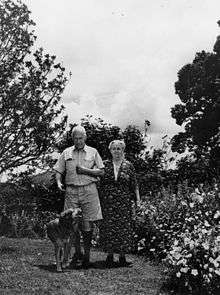Inigo Owen Jones

Inigo Owen Jones (1 December 1872 – 14 November 1954) was a meteorologist and farmer in Queensland, Australia.
Early life
Inigo Owen Jones was born in Croydon, Surrey, England to Owen Jones a civil engineer and a descendant of the architect Inigo Jones. His mother was from the Bernoulli family of mathematicians, and Inigo attributed his interest in meteorology and astronomy to this background. Upon his death, his cousin, Archibald Bernoulli of Melbourne, a direct descendent of the Bernoulli family, placed a notice in The Argus newspaper in Melbourne.
In 1874 Jones's parents migrated to Australia, settling on a property called Crohamhurst in the Glass House Mountains north of Brisbane in eastern Queensland. He became interested in meteorology while working on the family farm.
He was for many years a synodsman of the Brisbane diocese of the Church of England.
Meteorology
The Queensland Government meteorologist Clement Lindley Wragge was so impressed with Inigo's ability as a schoolboy that he recruited him as an assistant in 1888.
Jones studied the variation in sunspot cycles that had been discovered by Eduard Bruckner, and came to the conclusion that anomalies were caused by the interaction of the planets Jupiter, Saturn, Uranus and Neptune. This became the basis of his long-range weather forecasts, although he never claimed to be able to make day-to-day predictions. Although Jones failed to have his methods recognised as soundly based, by any substantial body of accredited scientific opinion he was widely recognised for his successes, especially by farmers.
Inigo Jones became a full-time forecaster and lecturer in 1927 and founded the privately operated Crohamhurst Observatory in south-east Queensland. An Australian Senate hearing was told in 1938 that Jones was a "wonderful patriot" and that he was "held in the highest esteem by the big man and also the small man on the land".
At 11 January 1939 meeting of the Australian and New Zealand Association for the Advancement of Science (ANZAAS) his ideas on cyclical variations theory was severely discredited, especially by Edward Kidson, the New Zealand government meteorologist, and yet farmers credited and worked their farms using his long-range forecasts.
Later life
Jones died at home on his farm at Crohamhurst, Queensland.
Legacy
His assistant Lennox Walker expanded Jones' theories and continued marketing long range forecasts until 2000, when he passed the business over to his own son Hayden Walker.
His Crohamhurst Observatory was listed on the Queensland Heritage Register in 2008.[1]
References
- ↑ "Crohamhurst Observatory (former) (entry 602682)". Queensland Heritage Register. Queensland Heritage Council. Retrieved 1 August 2014.
Sources
- Australian Science and Technology Heritage Centre (2001). "Federation and Meteorology", retrieved 30 December 2005.
- Commonwealth Bureau of Meteorology (2001). 100 Years of Science and Service Commonwealth Bureau of Meteorology
- Holthouse, Hector (1971). Cyclone. Rigby. ISBN 0-85179-290-1.
- Sherratt, Tim (2005) "Inigo Jones: the weather prophet", retrieved 30 December 2005.
External links
![]() Media related to Inigo Owen Jones at Wikimedia Commons
Media related to Inigo Owen Jones at Wikimedia Commons
- Bright Sparcs Biographical entry
- John Steele, "Jones, Inigo Owen (1872–1954)" from the Australian Dictionary of Biography
- "EVERYBODY KNOWS THE NAME.". The Courier-Mail (Brisbane, Qld. : 1933 - 1954). Brisbane, Qld.: National Library of Australia. 1 July 1954. p. 2. Retrieved 24 July 2015. — Newspaper article about Inigo Jones published shortly before his death in 1954